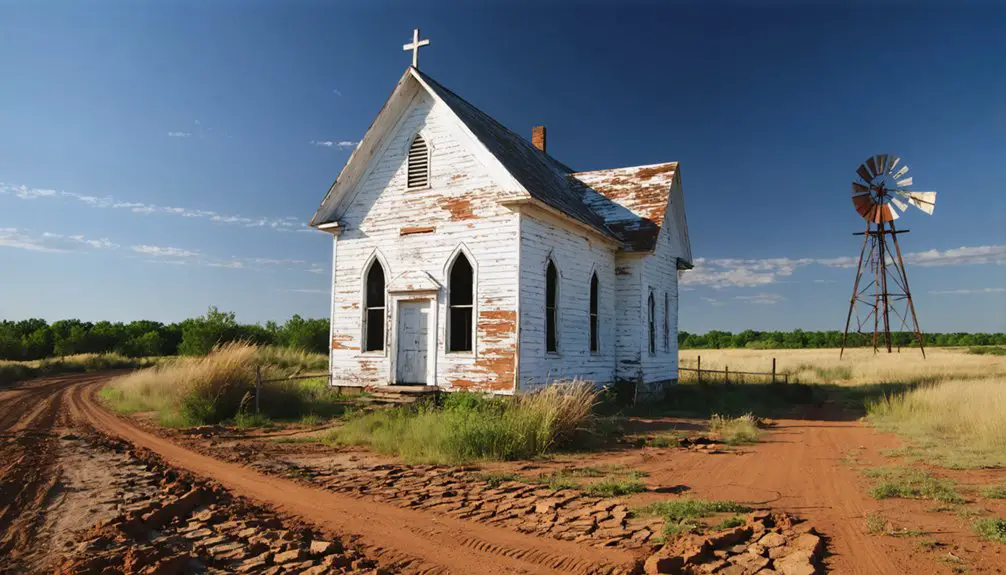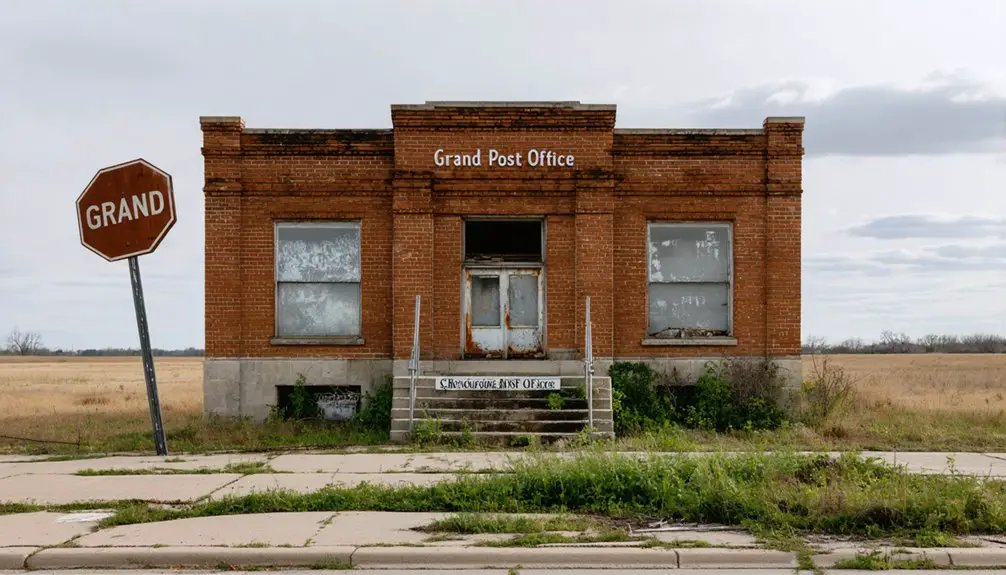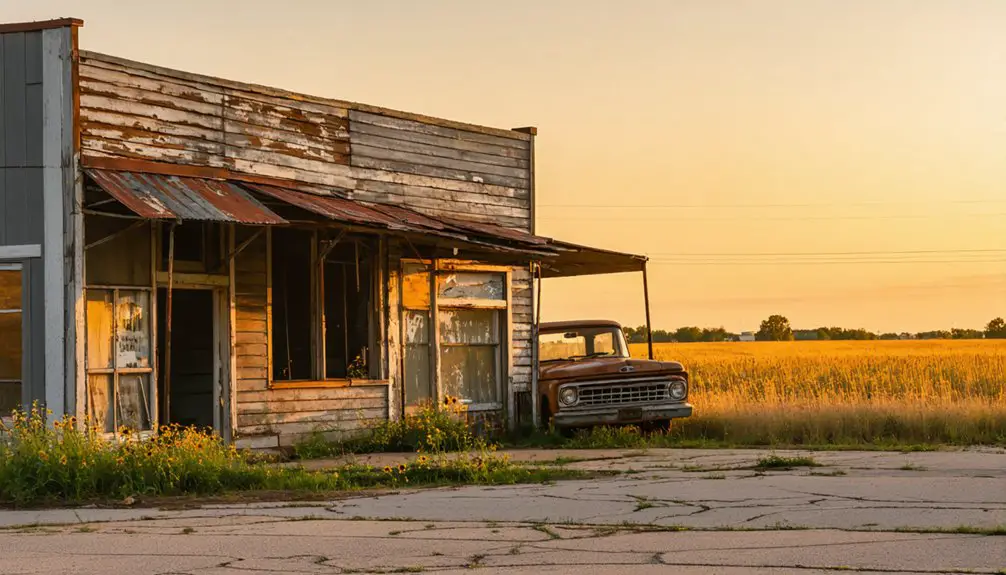You’ll find Grand’s stone ruins along Oklahoma’s Canadian River, where this ghost town once thrived as Day County’s seat from 1896 to 1907. Originally called Ioland, it was renamed to honor Judge Alcorn’s son Grandville and flourished with a courthouse, hotel, and store. After losing its county seat status to Arnett in 1908, Grand gradually declined until its post office closed in 1943. The weathered foundations and cemetery hold countless frontier stories waiting to be discovered.
Key Takeaways
- Grand was originally named Ioland before being relocated across the Canadian River and renamed to honor Grandville Alcorn.
- The town served as Day County’s seat from 1896 until 1907, when Oklahoma achieved statehood and administrative changes led to decline.
- Grand’s post office closed in 1943, marking the end of essential services and solidifying its status as a ghost town.
- Physical remnants include foundation outlines, weathered stonework, ruins of a schoolhouse, chapel walls, and an old general store site.
- Grand was listed on the National Register of Historic Places in 1972, with its cemetery serving as the primary burial ground.
Origins of Grand’s Settlement and Early Days
When Oklahoma Territory was still taking shape, the settlement of Ioland emerged as the county seat of “E” County, which would later become Day County.
You’ll find that settlement patterns in this region were heavily influenced by its location on the Cheyenne Arapaho reserve before the territory opened for broader settlement.
As county boundary changes swept through the territory, Ioland underwent a significant transformation.
The town relocated across the Canadian River, and you’d know it from then on as Grand.
This move reflected the dynamic nature of Oklahoma’s pre-statehood era, where communities often adapted to shifting administrative boundaries.
The settlement quickly established itself with essential facilities, including a post office and courthouse, becoming a hub for legal and administrative functions in the newly organized territory.
The name required careful disambiguation efforts to distinguish it from other locations sharing the “Grand” title.
Like many ghost towns in Oklahoma, Grand’s eventual decline was influenced by factors such as resource depletion and shifting population patterns.
From Ioland to Grand: The Story Behind the Name
You’ll find that Grand’s origins trace back to its first incarnation as Ioland, which served as the county seat of “E” County before the town relocated across the Canadian River.
After the move, the town’s new name honored Grandville Alcorn, whose father Robert held the position of county judge during this pivotal period.
The change from Ioland to Grand marked a significant shift in the settlement’s geography and reflected the influence of prominent judicial families in shaping Oklahoma’s territorial communities. When Oklahoma achieved statehood in 1907, the area underwent significant administrative changes as Day County was divided between Ellis and Roger Mills counties.
Original Name Ioland
Before its transformation into Grand, the frontier settlement of Ioland served as the county seat of Day County in Oklahoma Territory, situated near the Canadian River in what would later become Ellis County.
You’ll find Ioland’s history marked by a brief but notable period of prosperity, featuring a store, hotel, courthouse, and several residences during its prime. The town’s decline mirrored many other settlements where railroad routing determined survival.
As you explore Oklahoma’s ghost town legacy, you’ll discover that Ioland’s story took a dark turn with the territory’s first lynching – that of J.L. Chandler, who was accused of poisoning the town’s water supply.
Like many ghost towns in Oklahoma, Ioland’s fate was sealed by changing circumstances and the loss of its prominence as a regional center.
Today, only the Ioland Cemetery remains as a memorial to this once-promising settlement, which lost its county seat status to Grand on November 13, 1893.
Judge Alcorn’s Family Legacy
The transformation of Ioland into Grand stands as a symbol to the influential Alcorn family’s deep roots in Oklahoma’s territorial history.
You’ll find their judicial heritage woven throughout the region’s development, beginning with Robert Alcorn’s role as county judge. The town’s renaming honored his son Grandville, reflecting the family’s significant impact on local governance. His position as assistant county attorney in 1915 marked the beginning of the family’s judicial influence.
The Alcorn influence extended beyond Day County’s dissolution into Oklahoma statehood, with their legacy continuing through Ellis County. Their commitment to judicial integrity stood in stark contrast to the Supreme Court scandal that would later rock Oklahoma in the 1960s.
You can trace their judicial lineage into the 20th century through Glenn Alcorn’s service, while the family’s connections to prominent social networks shaped the area’s legal landscape.
Today, Grand’s listing on the National Register of Historic Places preserves the memory of this remarkable family’s contributions to early Oklahoma governance.
Canadian River Location Move
Situated along the unpredictable Canadian River, Ioland’s original settlement faced persistent challenges from flooding and treacherous quicksand that ultimately forced its relocation to higher ground.
The river’s braided channels and seasonal water fluctuations made river navigation particularly hazardous, disrupting the community’s daily life and commerce. The river’s massive drainage basin size of 47,700 square miles contributed to its volatile nature.
You’ll find that settlement patterns along the Canadian River were heavily influenced by transportation needs, especially after the Chicago, Rock Island & Pacific Railway built its bridge in 1891. Many settlers, including African American migrants from Oklahoma, sought opportunities in the region during the early 1900s.
The town’s residents, seeking stability and better access to emerging rail routes, made the strategic decision to move their community.
They established Grand at a more favorable location, joining other settlements that had already adapted to the river’s challenging nature by relocating to safer, more sustainable sites.
Life as the County Seat of Day County
During its fifteen-year tenure as county seat of Day County, Grand stood as an essential hub of governmental activity and civic life in Oklahoma Territory.
You’d find the courthouse at the heart of town, where officials managed county records and legal proceedings from a secure vault that still exists today.
Political tensions defined the era, particularly in the heated “Free Grass” versus “Herd Law” debates that pitted ranchers against farmers.
Agricultural conflicts erupted as cattle damaged crops, sometimes leading to violent confrontations – including a notorious 1901 lynching.
The town’s prominence drew various professionals, from legal representatives to government workers, while the post office served as a significant communication center.
Daily life revolved around civic duties, farming, and the complex dynamics between agricultural settlers and cattle interests, much like the patterns seen in Day County, South Dakota which was established in 1880.
The Canadian River Relocation

As changes to the Canadian River’s watershed management intensified in the mid-20th century, Grand’s fate became increasingly tied to water resource developments and infrastructural shifts along this historic waterway.
You’ll find that river management efforts, including the landmark 1952 Canadian River Compact, transformed the region’s landscape and settlement patterns.
The historical impact on Grand was particularly significant as water resource projects reshaped the area.
The town, which had already served as a focal point for military campaigns and early settler routes along the Canadian River, faced new challenges as infrastructure projects altered traditional transportation networks.
While Oklahoma gained unrestricted use of the river’s water within its borders, these developments contributed to shifting economic patterns that affected river towns like Grand, ultimately influencing its decline.
Physical Remnants and Historical Landmarks
Today’s visitors to Grand will find scattered yet telling remnants of this once-vibrant Oklahoma settlement. You’ll discover foundation outlines and weathered stonework that mark where homes and businesses once stood, while remnant preservation efforts by local historical societies help document these rapidly declining structures.
Architectural analysis reveals the town’s simple yet practical building style, with single-story structures built from local materials. You can trace the original street grid through degraded roadbeds, and explore the old cemetery where pioneer inscriptions tell stories of early settlers.
Notable landmarks include the ruins of a schoolhouse, chapel walls, and the old general store site. While no formal infrastructure exists, dirt trails lead you through this ghost town’s atmospheric remains, where abandoned wells and fence lines paint a picture of frontier life.
The Role of Administrative Changes in Grand’s Decline

While Grand initially flourished as the seat of Day County from 1896, its administrative prominence began unraveling with Oklahoma’s statehood in 1907.
The dissolution of Day County split the region between Ellis and Roger Mills counties, with Grand briefly retaining county seat status in Ellis County.
However, you’ll find that the most devastating administrative shift came in 1908 when Arnett claimed the county seat designation.
The loss proved catastrophic to Grand’s liveliness. When the courthouse and administrative offices relocated to Arnett, they took with them the essential government functions that had sustained the town’s relevance.
Without its role as a center of county operations, Grand lost its primary reason for existence. The abandoned courthouse and vault stood as silent witnesses to the town’s diminishing importance.
Legacy of the Post Office (1892-1943)
You’ll find the Grand post office‘s most significant legacy in its half-century run from 1892 to 1943, when it served as the primary communication lifeline for the frontier settlement.
As a critical hub for mail distribution, news circulation, and goods ordering, the post office unified the dispersed rural population while validating Grand’s importance in the region.
The facility’s closure in 1943 marked the end of an era, reflecting the town’s diminishing viability as residents relocated and transportation routes shifted away from the once-thriving community.
Mail Service Operations Period
During Grand’s fifty-one year period as a postal hub, the town’s post office served as an indispensable communications link between 1892 and 1943, spanning Oklahoma’s territorial era through early statehood.
You’ll find that mail routes connected Grand to nearby towns and larger postal centers, while rural delivery innovations in the late 19th century expanded the office’s reach to surrounding areas.
The post office’s operations evolved with federal standards, requiring secure mail receptacles and efficient distribution methods.
Postmasters wielded significant influence, often determining the office’s location within the community. They guaranteed mail reached its intended recipients safely, while postal riders and carriers operated under strict federal guidelines.
Throughout its operation, the facility handled everything from personal letters to government communications, maintaining crucial connections for this frontier community.
Community Hub Until Closure
Beyond its postal operations, Grand’s post office served as the town’s essential communication nexus and social anchor from 1892 to 1943.
You’d find residents gathering there daily, exchanging local news and conducting business while collecting their mail. The facility didn’t just distribute letters – it connected you to the wider world through money orders, parcel shipping, and government documents.
The postmaster’s influence extended far beyond postal services, often taking on civic leadership roles that shaped the town’s development.
Community gatherings at the post office strengthened social bonds and supported local commerce through reliable mail-order connections.
When the facility closed in 1943, you lost more than just a post office – the shutdown marked a turning point in Grand’s decline, weakening the community ties that had helped the town thrive.
Historical Significance and National Recognition

While many Oklahoma ghost towns faded into obscurity, Grand’s historical significance earned it a spot on the National Register of Historic Places in 1972.
As one of Oklahoma Territory’s early centers of historical governance, Grand played a pivotal role in shaping the region’s development. You’ll find its territorial significance reflected in its tenure as county seat for both Day County and later Ellis County, marking a vital period of administrative evolution from 1896 to 1908.
Unlike typical ghost towns that vanished due to mining busts or railroad bypasses, Grand’s story uniquely captures the political and administrative shifts that accompanied Oklahoma’s change to statehood.
Today, you can still visit the site where courthouse footings and the records vault stand as evidence to Grand’s administrative heritage.
Cemetery Stories and Local Heritage
The Grand Cemetery stands as a solemn guardian of local history at coordinates 36°00′47″N 99°49′05″W, serving as the primary burial ground for Ellis County’s early settlers and officials.
Nestled in Ellis County, Grand Cemetery eternally watches over the pioneers who shaped this land, marking their final resting place.
You’ll find headstones marking family plots and individual burials that tell the story of frontier life, including possible graves of military veterans and descendants of Grandville Alcorn, the town’s namesake.
While specific ghost tales haven’t been documented for Grand Cemetery, you’ll discover it shares common threads with other Oklahoma rural cemeteries where cemetery legends speak of protective spirits and apparitions in historical clothing.
The site’s inclusion on the National Register of Historic Places since 1972 preserves these stories alongside the physical remnants, offering you a glimpse into the vanished community’s social fabric.
Ghost Town Status in Oklahoma’s History

You’ll find Grand’s administrative evolution mirrors many Oklahoma ghost towns, shifting from a bustling community to near abandonment as economic and social forces reshaped the region.
Grand’s physical remnants today include scattered foundation stones, weathered grave markers, and overgrown roadbeds that once connected the town to essential trade routes.
These architectural fragments tell the story of Oklahoma’s boom-and-bust cycle, where towns like Grand emerged rapidly during periods of prosperity only to fade as circumstances changed.
Administrative Evolution Impact
As Oklahoma approached statehood in 1907, Grand’s administrative significance began its fateful decline through a series of governmental reorganizations.
You’ll find that Day County’s dissolution marked the first blow to Grand’s authority, as the territory split between Ellis and Roger Mills counties. The social dynamics shifted dramatically when Grand lost its county seat status to Arnett in 1908, triggering profound economic shifts throughout the region.
The town’s administrative decline continued with each passing decade. You can trace Grand’s diminishing importance through the gradual withdrawal of government services – from the courthouse’s relocation to the post office’s closure in 1943.
What you’re seeing in Grand’s story is a classic example of how administrative changes can strip a town of its essence, ultimately leading to its abandonment.
Lost Town’s Physical Remnants
Standing among Grand’s decaying structures today, you’ll find a haunting tribute to Oklahoma’s boom-and-bust heritage.
Urban decay has transformed this once-bustling town into a collection of deteriorating buildings, where nature steadily reclaims what humanity left behind.
As you explore the site, you’ll need to be mindful of structural safety concerns:
- Collapsed roofs and unstable floorboards make interior exploration extremely dangerous
- Commercial buildings and former homes stand as hollow shells of their past
- Vegetation growth threatens remaining foundations and walls
- Environmental hazards from previous industrial activity pose additional risks
The town’s physical remnants tell a stark story of rapid abandonment, with buildings appearing frozen in time from when their last occupants departed.
These skeletal structures serve as silent witnesses to the harsh economic realities that forced Grand’s residents to seek opportunities elsewhere.
Frequently Asked Questions
What Was the Peak Population of Grand During Its Most Prosperous Years?
You’ll find no exact peak population records, but economic factors suggest several hundred residents during the town’s height as county seat, before population growth reversed after 1908’s administrative relocation.
Were There Any Notable Crimes or Lawlessness Incidents in Grand’s History?
While you might expect wild tales, there’s no clear record of major criminal activities in Grand. Like many frontier towns, it likely had typical law enforcement challenges during its brief existence.
What Businesses and Industries Operated in Grand Before Its Decline?
You’d have found mining operations, railroads, and general stores serving the local workforce. Economic shifts and railroad impact gradually reduced business activity as mining declined and transportation patterns changed.
Did Any Famous Historical Figures Ever Visit or Live in Grand?
You won’t find records of any famous visitors or notable historical figures in Grand’s history. The town’s significance came from its role as a county seat rather than from distinguished personalities.
What Natural Disasters or Severe Weather Events Affected Grand’s Development?
Like a hammer to glass, tornado impacts shattered Grand’s development. You’ll find records of destructive storms and flooding history that repeatedly battered the settlement throughout its brief existence.
References
- https://en.wikipedia.org/wiki/List_of_ghost_towns_in_Oklahoma
- https://en.wikipedia.org/wiki/Grand
- https://www.okhistory.org/publications/enc/entry?entry=GH002
- https://gateway.okhistory.org/ark:/67531/metadc2123396/
- https://www.kgou.org/oklahoma-news/2018-10-01/how-curious-an-all-female-ghost-town
- https://www.youtube.com/watch?v=jcbyntLCj2U
- https://kids.kiddle.co/Grand
- http://blogoklahoma.us/place/186/ellis/grand
- https://en.wikipedia.org/wiki/Ioland
- https://www.okhistory.org/publications/enc/entry?entry=OK025



